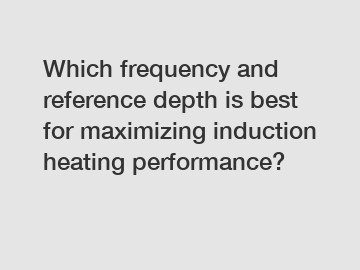Which frequency and reference depth is best for maximizing induction heating performance?
Which frequency and reference depth is best for maximizing induction heating performance?
The optimal frequency and reference depth for maximizing induction heating performance depend on several factors. Induction heating is a process that uses alternating electric currents to generate heat in an electrically conducting material. The frequency of the alternating current and the depth at which it penetrates the material are two key parameters that determine the efficiency and effectiveness of induction heating.
In general, higher frequencies result in shallower depth of penetration, while lower frequencies offer deeper penetration. This is because the skin effect, which causes the current to concentrate near the surface of the material, becomes more pronounced at higher frequencies. Therefore, for applications that require heating a thin surface layer, higher frequencies are preferred.

On the other hand, when the goal is to heat a larger volume of material, lower frequencies are more suitable. The deeper penetration of lower frequencies ensures that the heat is distributed evenly throughout the bulk of the material. This is particularly important in applications such as metal hardening or heat treatment, where consistent and uniform heating is necessary.
The choice of frequency also affects the efficiency of induction heating. Higher frequencies often result in higher power losses due to the skin effect. The concentrated current flow near the surface leads to higher resistive losses, reducing the overall efficiency of the process. In contrast, lower frequencies reduce power losses and improve the efficiency of the induction heating system.
The reference depth, or the depth at which the alternating current is applied, also plays a crucial role in maximizing induction heating performance. The reference depth should be chosen to match the desired heating depth. If the reference depth is too shallow, the induction heating may not reach the desired depth in the material. Conversely, if the reference depth is too deep, unnecessary heating of the surrounding material may occur, leading to energy wastage.
To determine the optimal frequency and reference depth for a specific induction heating application, careful consideration of the desired heating depth, material properties, and heating time is necessary. Additionally, experimental trials and simulations can be conducted to validate the chosen parameters and ensure maximum performance.
In conclusion, the frequency and reference depth for maximizing induction heating performance depend on the specific requirements of the application. Higher frequencies are suitable for shallow heating, while lower frequencies are preferred for deeper penetration. The choice of frequency also affects the efficiency of the induction heating process. Furthermore, selecting the appropriate reference depth is crucial to ensure effective and efficient heating. By carefully considering these factors and conducting thorough experimentation, maximum induction heating performance can be achieved.
If you are looking for more details, kindly visit induction billet heater working principle, industrial induction heater, how to make induction heating coil.

Comments
0